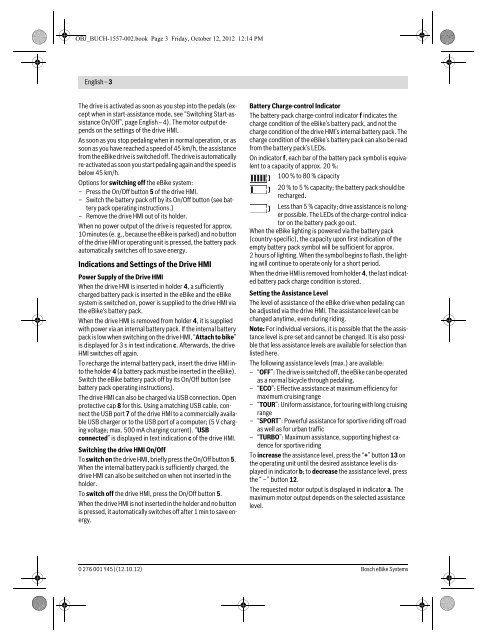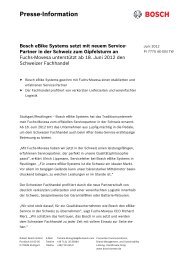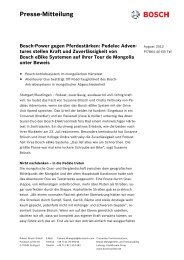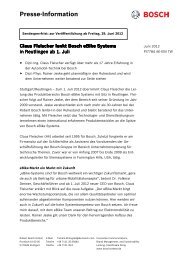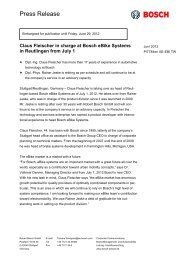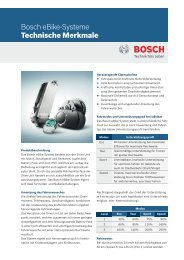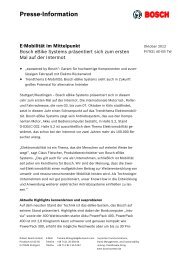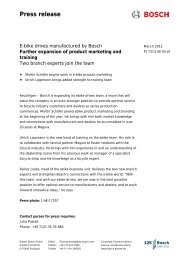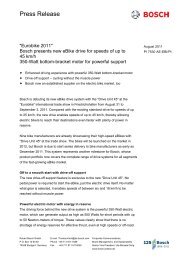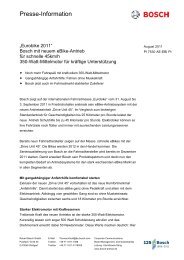English - Bosch eBike Systems
English - Bosch eBike Systems
English - Bosch eBike Systems
- TAGS
- bosch
- ebike
- www.bosch-ebike.de
You also want an ePaper? Increase the reach of your titles
YUMPU automatically turns print PDFs into web optimized ePapers that Google loves.
OBJ_BUCH-1557-002.book Page 3 Friday, October 12, 2012 12:14 PM<br />
<strong>English</strong>–3<br />
The drive is activated as soon as you step into the pedals (except<br />
when in start-assistance mode, see “Switching Start-assistance<br />
On/Off”, page <strong>English</strong>–4). The motor output depends<br />
on the settings of the drive HMI.<br />
As soon as you stop pedaling when in normal operation, or as<br />
soon as you have reached a speed of 45 km/h, the assistance<br />
from the <strong>eBike</strong> drive is switched off. The drive is automatically<br />
re-activated as soon you start pedaling again and the speed is<br />
below 45 km/h.<br />
Options for switching off the <strong>eBike</strong> system:<br />
– Press the On/Off button 5 of the drive HMI.<br />
– Switch the battery pack off by its On/Off button (see battery<br />
pack operating instructions.)<br />
– Remove the drive HMI out of its holder.<br />
When no power output of the drive is requested for approx.<br />
10 minutes (e. g., because the <strong>eBike</strong> is parked) and no button<br />
of the drive HMI or operating unit is pressed, the battery pack<br />
automatically switches off to save energy.<br />
Indications and Settings of the Drive HMI<br />
Power Supply of the Drive HMI<br />
When the drive HMI is inserted in holder 4, a sufficiently<br />
charged battery pack is inserted in the <strong>eBike</strong> and the <strong>eBike</strong><br />
system is switched on, power is supplied to the drive HMI via<br />
the <strong>eBike</strong>'s battery pack.<br />
When the drive HMI is removed from holder 4, it is supplied<br />
with power via an internal battery pack. If the internal battery<br />
pack is low when switching on the drive HMI, “Attach to bike”<br />
is displayed for 3 s in text indication c. Afterwards, the drive<br />
HMI switches off again.<br />
To recharge the internal battery pack, insert the drive HMI into<br />
the holder 4 (a battery pack must be inserted in the <strong>eBike</strong>).<br />
Switch the <strong>eBike</strong> battery pack off by its On/Off button (see<br />
battery pack operating instructions).<br />
The drive HMI can also be charged via USB connection. Open<br />
protective cap 8 for this. Using a matching USB cable, connect<br />
the USB port 7 of the drive HMI to a commercially available<br />
USB charger or to the USB port of a computer; (5 V charging<br />
voltage; max. 500 mA charging current). “USB<br />
connected” is displayed in text indication c of the drive HMI.<br />
Switching the drive HMI On/Off<br />
To switch on the drive HMI, briefly press the On/Off button 5.<br />
When the internal battery pack is sufficiently charged, the<br />
drive HMI can also be switched on when not inserted in the<br />
holder.<br />
To switch off the drive HMI, press the On/Off button 5.<br />
When the drive HMI is not inserted in the holder and no button<br />
is pressed, it automatically switches off after 1 min to save energy.<br />
Battery Charge-control Indicator<br />
The battery-pack charge-control indicator f indicates the<br />
charge condition of the <strong>eBike</strong>’s battery pack, and not the<br />
charge condition of the drive HMI’s internal battery pack. The<br />
charge condition of the <strong>eBike</strong>’s battery pack can also be read<br />
from the battery pack’s LEDs.<br />
On indicator f, each bar of the battery pack symbol is equivalent<br />
to a capacity of approx. 20 %:<br />
100 % to 80 % capacity<br />
20 % to 5 % capacity; the battery pack should be<br />
recharged.<br />
Less than 5 % capacity; drive assistance is no longer<br />
possible. The LEDs of the charge-control indicator<br />
on the battery pack go out.<br />
When the <strong>eBike</strong> lighting is powered via the battery pack<br />
(country-specific), the capacity upon first indication of the<br />
empty battery pack symbol will be sufficient for approx.<br />
2 hours of lighting. When the symbol begins to flash, the lighting<br />
will continue to operate only for a short period.<br />
When the drive HMI is removed from holder 4, the last indicated<br />
battery pack charge condition is stored.<br />
Setting the Assistance Level<br />
The level of assistance of the <strong>eBike</strong> drive when pedaling can<br />
be adjusted via the drive HMI. The assistance level can be<br />
changed anytime, even during riding.<br />
Note: For individual versions, it is possible that the the assistance<br />
level is pre-set and cannot be changed. It is also possible<br />
that less assistance levels are available for selection than<br />
listed here.<br />
The following assistance levels (max.) are available:<br />
– “OFF”: The drive is switched off, the <strong>eBike</strong> can be operated<br />
as a normal bicycle through pedaling.<br />
– “ECO”: Effective assistance at maximum efficiency for<br />
maximum cruising range<br />
– “TOUR”: Uniform assistance, for touring with long cruising<br />
range<br />
– “SPORT”: Powerful assistance for sportive riding off road<br />
as well as for urban traffic<br />
– “TURBO”: Maximum assistance, supporting highest cadence<br />
for sportive riding<br />
To increase the assistance level, press the “+” button 13 on<br />
the operating unit until the desired assistance level is displayed<br />
in indicator b; to decrease the assistance level, press<br />
the “ –” button 12.<br />
The requested motor output is displayed in indicator a. The<br />
maximum motor output depends on the selected assistance<br />
level.<br />
0 276 001 Y45 | (12.10.12) <strong>Bosch</strong> <strong>eBike</strong> <strong>Systems</strong>


